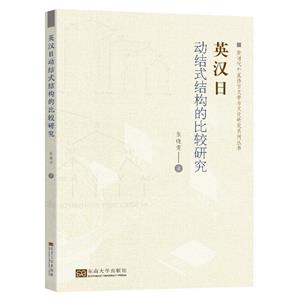掃一掃
關注中圖網
官方微博
本類五星書更多>
-
>
妙相梵容
-
>
基立爾蒙文:蒙文
-
>
我的石頭記
-
>
心靈元氣社
-
>
女性生存戰爭
-
>
縣中的孩子 中國縣域教育生態
-
>
(精)人類的明天(八品)
英漢日動結式結構的比較研究/新時代外國語言文學與文化研究系列叢書 版權信息
- ISBN:9787576601671
- 條形碼:9787576601671 ; 978-7-5766-0167-1
- 裝幀:一般純質紙
- 冊數:暫無
- 重量:暫無
- 所屬分類:>
英漢日動結式結構的比較研究/新時代外國語言文學與文化研究系列叢書 內容簡介
本書的主要內容基于Washio的強/弱動結式的理論,比較研究了英漢日語中的動結式結構,并從句法學視角解釋漢語動結式結構與英語和日語動結式結構的相同點與異同點。此外,本書在研究漢語兩種動結式結構時,基于Folli的三層語義構造理論,從一嶄新視角定位了DE(得)在漢語動結式結構中的功能,即表示過程(Process)。根據上述兩點,本書*后分析了漢語動結式Vtransitive-Vunaccusative式所產生的歧義現象,為對外漢語教學提供一定的借鑒與指導。
英漢日動結式結構的比較研究/新時代外國語言文學與文化研究系列叢書 目錄
Chapter 1 Resultative Constructions in English, Japanese and Chinese
1.1 Defining Resultatives and Resultative Constructions
1.1.1 English Resultative Constructions
1.1.2 Japanese Resultative Constructions
1.1.3 Chinese Resultative Constructions
1.2 Two Sharp Differences between Chinese Resultative Constructions
1.2.1 The Similarities between Chinese Two Types of Resultative Constructions
1.2.2 The First Sharp Difference between Chinese Resultative Constructions
1.2.3 The Possible Grammatical Weak V-DE-(NP)-A Construction in Chinese
1.2.4 The Second Sharp Difference between Chinese Resultative Constructions
1.3 Organization of the Book
Chapter 2 Chomsky's General Framework and Works on Resultative Constructions
2.1 Chomsky's General Framework in Syntax
2.1.1 Phrasal Structures
2.1.2 Theta Roles and the Deep Structures
2.1.3 Move
2.1.4 A Case Study in English
2.2 Foll's Three-layer System and Lin's Proposal
2.3 More on DE in V-DE-(NP)-A Construction: Previous Analyses
2.3.1 V-DE as a Phonological Word
2.3.2 DE as a Preposition
2.3.3 DE as a Derived Suffix
2.3.4 Zhu's Proposal of DE as a Semantic Element [BECOME]
2.4 Stage-level Predicates and Individual-level Predicates
2.4.1 Kratzer's Distinguishment of SLPs with ILPs by Event Argument
2.4.2 Zhang's Division of Chinese Adjectives
2.5 Li's Argument Structure Analysis
2.6 Li and Thompson's Analysis
2.6.1 Serial Verb Constructions
2.6.2 The Syntactic Structures of Subject-oriented V-V-(NP) Compounds
2.7 Sybesma's Small Clause Analysis
2.7.1 Sybesma's Small Clause Analysis on Resultative V-V-(NP) Compounds
2.7.2 Sybesma's Small Clause Analysis on V-DE-(NP)-V Constructions
2.8 Liang's Analysis of Subject-oriented Resultative V-V-(NP) Compounds
Chapter 3 V-DE-(NP)-A Constructions in Chinese as Strong Resultatives
3.1 Strong and Weak Resultatives in Chinese Resultative Constructions
3.2 V-DE-(NP)-A Construction in Chinese as Strong Resultatives
3.2.1 The Syntactic Structures of Weak Resultatives in Chinese
3.2.2 The Syntactic Structures of Strong Resultatives in Chinese
Chapter 4 The Possibility of Grammatical Weak V-DE-(NP)-A Constructions
4.1 The Possibility of Grammatical Weak V-DE-(NP)-A: On the Occasion of ILP
4.2 The Possibility of Grammatical Weak V-DE-(NP )-A: On the Occasion of Degree Words
Chapter 5 The Subject-oriented and Object-oriented Interpretations in Chinese
5.1 The Subject-oriented and Object-oriented Interpretations in V-V-(NP) Compounds
5.2 The Object-oriented Interpretation in Chinese V-DE-(NP )-V Constructions
5.3 The Syntactic Structures of Subject-oriented and Object-oriented Interpretations
5.3.1 The Syntactic Structure of the Subject-oriented Resultative V-V-(NP) Compounds
5.3.2 The Syntactic Structures of the Object-oriented V-DE-(NP)-V Constructions
5.3.3 The Syntactic Structures of the Object-oriented Resultative V-V-(NP) Compounds
5.4 The Subject-oriented Interpretation in Japanese Resultative V-V compounds
Chapter 6 Conclusion
Bibiography
Acknowledgements
1.1 Defining Resultatives and Resultative Constructions
1.1.1 English Resultative Constructions
1.1.2 Japanese Resultative Constructions
1.1.3 Chinese Resultative Constructions
1.2 Two Sharp Differences between Chinese Resultative Constructions
1.2.1 The Similarities between Chinese Two Types of Resultative Constructions
1.2.2 The First Sharp Difference between Chinese Resultative Constructions
1.2.3 The Possible Grammatical Weak V-DE-(NP)-A Construction in Chinese
1.2.4 The Second Sharp Difference between Chinese Resultative Constructions
1.3 Organization of the Book
Chapter 2 Chomsky's General Framework and Works on Resultative Constructions
2.1 Chomsky's General Framework in Syntax
2.1.1 Phrasal Structures
2.1.2 Theta Roles and the Deep Structures
2.1.3 Move
2.1.4 A Case Study in English
2.2 Foll's Three-layer System and Lin's Proposal
2.3 More on DE in V-DE-(NP)-A Construction: Previous Analyses
2.3.1 V-DE as a Phonological Word
2.3.2 DE as a Preposition
2.3.3 DE as a Derived Suffix
2.3.4 Zhu's Proposal of DE as a Semantic Element [BECOME]
2.4 Stage-level Predicates and Individual-level Predicates
2.4.1 Kratzer's Distinguishment of SLPs with ILPs by Event Argument
2.4.2 Zhang's Division of Chinese Adjectives
2.5 Li's Argument Structure Analysis
2.6 Li and Thompson's Analysis
2.6.1 Serial Verb Constructions
2.6.2 The Syntactic Structures of Subject-oriented V-V-(NP) Compounds
2.7 Sybesma's Small Clause Analysis
2.7.1 Sybesma's Small Clause Analysis on Resultative V-V-(NP) Compounds
2.7.2 Sybesma's Small Clause Analysis on V-DE-(NP)-V Constructions
2.8 Liang's Analysis of Subject-oriented Resultative V-V-(NP) Compounds
Chapter 3 V-DE-(NP)-A Constructions in Chinese as Strong Resultatives
3.1 Strong and Weak Resultatives in Chinese Resultative Constructions
3.2 V-DE-(NP)-A Construction in Chinese as Strong Resultatives
3.2.1 The Syntactic Structures of Weak Resultatives in Chinese
3.2.2 The Syntactic Structures of Strong Resultatives in Chinese
Chapter 4 The Possibility of Grammatical Weak V-DE-(NP)-A Constructions
4.1 The Possibility of Grammatical Weak V-DE-(NP)-A: On the Occasion of ILP
4.2 The Possibility of Grammatical Weak V-DE-(NP )-A: On the Occasion of Degree Words
Chapter 5 The Subject-oriented and Object-oriented Interpretations in Chinese
5.1 The Subject-oriented and Object-oriented Interpretations in V-V-(NP) Compounds
5.2 The Object-oriented Interpretation in Chinese V-DE-(NP )-V Constructions
5.3 The Syntactic Structures of Subject-oriented and Object-oriented Interpretations
5.3.1 The Syntactic Structure of the Subject-oriented Resultative V-V-(NP) Compounds
5.3.2 The Syntactic Structures of the Object-oriented V-DE-(NP)-V Constructions
5.3.3 The Syntactic Structures of the Object-oriented Resultative V-V-(NP) Compounds
5.4 The Subject-oriented Interpretation in Japanese Resultative V-V compounds
Chapter 6 Conclusion
Bibiography
Acknowledgements
展開全部
英漢日動結式結構的比較研究/新時代外國語言文學與文化研究系列叢書 作者簡介
張曉雯,博士、副教授,現為淮陰工學院大外部副主任,研究方向為比較語言學;先后主持完成了江蘇省社會科學基金項目、江蘇省教育廳高校哲學社會科學基金項目、江蘇省社科聯研究課題、淮安市社科類研究課題,發表學術論文十余篇,其中CSSCI來源期刊1篇,國外期刊8篇。
書友推薦
- >
大紅狗在馬戲團-大紅狗克里弗-助人
- >
隨園食單
- >
中國人在烏蘇里邊疆區:歷史與人類學概述
- >
月亮虎
- >
山海經
- >
回憶愛瑪儂
- >
新文學天穹兩巨星--魯迅與胡適/紅燭學術叢書(紅燭學術叢書)
- >
伯納黛特,你要去哪(2021新版)
本類暢銷

















